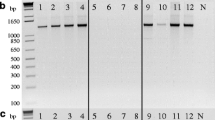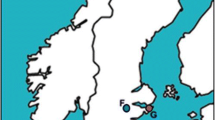Abstract
Eleven pathotype groups (A-K), including five not previously reported, ofDidymella rabiei (anamorphAscochyta rabiei), representing isolates of the pathogen from Ascochyta blight-affected chickpeas mainly from India, Pakistan, Spain and the USA, were characterized using 44 single-spore isolates tested against seven differential chickpea lines. Of 48 isolates tested for mating type, 58% belonged to MAT 1-1 and 42% to MAT 1-2. Thirty-nineD. rabiei isolates, as well as two isolates ofAscochyta pisi and six isolates of unrelated fungi, were analyzed using Randomly Amplified Polymorphic DNAs (RAPDs) employing five primers (P2 at 40°C, and OPA3, OPC1, OPC11 and OPC20 at 35°C). Computer cluster analysis (UPGMA / NTSYS-PC) detected a relatively low level of polymorphism among all theD. rabiei isolates, although atca 7% dissimilarity,ca 10 RAPD groups [I-X] were demarcated, as well as subclustering within the larger groups. By the same criteria, the maximum dissimilarity for the whole population ofD. rabiei isolates wasca 13%. No correlation was found between different RAPD groups, pathotype, or mating type ofD. rabiei, although some evidence of clustering based on geographic origin was detected. The use of RAPDs enabled us to identify specific DNA fragments that may have a potential use as genetic markers in sexual crosses, but none which could be used as virulence markers.
Similar content being viewed by others
References
Alam, S.S., Bitton, J.N., Slawin, A.M.Z., Williams, R.N., Shepard, R.N. and Strange, R.N. (1989) Chickpea blight: production of the phytotoxins solanopyrone a and c byAscochyta rabiei.Phytochemistry 28:2627–2631.
Austin, B. and Priest, F. (1986) Modern Bacterial Taxonomy. Van Nostrand Reinhold, New York, NY.
Fischer, C, Porta-Puglia, A. and Barz, W. (1995) RAPD analysis of pathogenic variability inAscochyta rabiei.J. Phytopathol. 143:601–607.
Grewal, J.S. (1984) Evidence of physiologic races inAscochyta rabiei of chickpea,in: Saxena, C. and Singh, K.B. [Eds.] Ascochyta Blight and Winter Sowing of Chickpea. pp. 55–65. Martinus Niijhoff, the Hague, the Netherlands.
Griffen, A.M., Bainbridge, B.W. and Heale, J.B. (1997) Ribosomal, mitochondrial and amplified DNA polymorphisms inVerticillium albo-atrum pathogenic to hops, lucerne and other plants.Mycol. Res. 101:1085–1091.
HohI, B., Weidermann, C, Hohl, U. and Barz, W. (1991) Isolation of solanopyrones a, b and c from culture filtrates and germination fluids ofAscochyta rabiei and aspects of phytotoxin action.J. Phytopathol. 132:193–206.
Jan, H. and Wiese, M.V. (1991) Virulence forms ofAscochyta rabiei affecting chickpea in the Palouse.Plant Dis. 75:904–906.
Kaiser, W.J. (1973) Factors affecting growth, sporulation, pathogenicity and survival ofAscochyta rabiei.Mycologia 65:444–447.
Kaiser, W.J. (1992) Epidemiology ofAscochyta rabiei.in: Singh, K.B. and Saxena, M.C. [Eds.] Disease Resistance Breeding in Chickpea, pp. 117–134. ICARDA, Aleppo, Syria.
Kaiser, W.J. (1995) Inter- and intranational spread of Ascochyta pathogens of chickpea, faba bean, and lentil.Can. J. Plant Pathol. 19:215–224.
Kaiser, W.J. and Muelbauer, F.J. (1988) An outbreak of Ascochyta blight of chickpea in the Pacific Northwest, USA, in 1987.Int. Chickpea Newsl. 18:16–17.
Karapapa, V.K., Bainbridge, B.W. and Heale, J.B. (1997) Morphological and molecular characterisation of the new speciesVerticillium longisporum pathogenic to oilseed rape.Mycol. Res. 101:1281–1294.
Kelly, A., Alcalá-Jiménez, A.R., Bainbridge, B.W., Heale, J.B., Pérez-Artés, E. and Jiménez-Díaz, R.M. (1994) Use of genetic fingerprinting and random amplified polymorphic DNA to characterize pathotypes ofFusarium oxysporum f.sp.ciceris infecting chickpea.Phytopathology 84:1293–1298.
McDonald, B.A., McDermott, J.B., Goodwin, S.B. and Allard, R.W. (1989) The population biology of host-pathogen interactions.Annu. Rev. Phytopathol. 27:77–94.
McDonald, B.A. and Martinez, J.P. (1990) DNA restriction fragment length polymorphisms amongMagnaporthe graminicola (anamorphSeptoria tritici) isolates collected from a single wheat field.Phytopathology 80:1368–1373.
Morjane, H., Geistlinger, J., Harrabi, M., Weising, K. and Kahl, G. (1994) Oligonucleotide fingerprinting detects genetic diversity amongAscochyta rabiei isolates from a single chickpea field in Tunisia.Curr. Genet. 26:191–197.
Navas-Cortés, J.A., Trapero-Casas, A. and Jiménez-Díaz, R.M. (1995) Survival ofDidymella rabiei in chickpea straw debris in Spain.Plant Pathol. 44:332–339.
Navas-Cortés, J.A., Trapero-Casas, A. and Jiménez-Díaz, R.M. (1998) Influence of relative humidity and temperature on development ofDidymella rabiei on chickpea debris.Plant Pathol. 47:57–66.
Nene, Y. and Reddy, M.V. (1987) Chickpea diseases and their control,in: Saxena, M.C. and Singh, K.B. [Eds.] The Chickpea. pp. 233–270. Commonwealth Agricultural Bureaux International, Oxon, UK.
Núñez-Cañete, R., Trapero-Casas, A. and Jiménez-Díaz, R.M. (1992) Virulencia y compatibilidad sexual de aislados deAscochyta rabiei. in: ResúmenesVI Congreso Latinoamericano de Fitopatología (Torremolinos, Spain), p. 26.
Porta-Puglia, A., Crino, P. and Mosconi, C. (1996) Variability in virulence to chickpea of an Italian population ofAscochyta rabiei.Plant Dis. 80:39–41.
Qureshi, S.H. and Alam, S.S. (1984) Pathogenic behaviour ofAscochyta rabiei isolates on different cultivars of chickpea in Pakistan.Int. Chickpea Newsl. 11:29–31.
Raeder, V. and Broda, P. (1985) Rapid preparation of DNA from filamentous fungi.Lett. Appl. Microbiol. 1:17–20.
Reddy, M.V. and Kabbabeh, S. (1985) Pathogenic variability inAscochyta rabiei (Pass.) Lab. in Syria and Lebanon.Phytopathol. Mediterr. 24:265–266.
Rohlf, F.J. (1993) NTSYS-pc, Version 1.80 Manual of Applied Biostatistics Inc., Setauket, NY.
Saxena, M.C., Cubero, J.I. and Weery, J. [Eds.] (1990) Present Status and Future Prospects of Chickpea Crop Production and Improvement in the Mediterranean Countries.Options Méditerranées, Sér. Séminaires 9:1–188.
Saxena, M.C. and Singh, K.B. [Eds.] (1984) Ascochyta Blight and Winter Sowing of Chickpeas. Martinus Niijhoff / Dr. W. Junk Publishers, the Hague, the Netherlands.
Trapero-Casas, A. and Jiménez-Díaz, R.M. (1986) Influence of sowing date on Fusarium wilt and Ascochyta blight of chickpea in southern Spain,in: O’Keeffe, L.E. and Muehlbauer, F.J. [Eds.] Poster Abstracts,Int. Food Legume Conf. (University of Idaho, Moscow, ID, USA), p. 11.
Trapero-Casas, A. and Kaiser, W.J. (1992) Influence of temperature, wetness period, plant age, and inoculum concentration on infection and development of Ascochyta blight of chickpea.Phytopathology 82:589–596.
Trapero-Casas, A. and Kaiser, W.J. (1992) Development ofDidymella rabiei on chickpea debris.Phytopathology 82:1261–1266.
Trapero-Casas, A., Navas-Cortés, J.A. and Jiménez-Díaz, R.M. (1996) Airborne ascospores ofDidymella rabiei as a major primary inoculum for Ascochyta blight epidemics in chickpea crops in southern Spain.Eur. J. Plant Pathol. 102:237–245.
Vir, S. and Grewal, J.S. (1974) Physiologic specialization inAscochyta rabiei, the causal organism of gram blight.Indian Phytopathol. 27:355–360.
Weising, Y., Kaemmer, D., Epplen, J.T., Weigan, F., Saxena, M. and Kahl, G. (1991) DNA fingerprinting ofAscochyta rabiei with synthetic oligodeoxynucleotides.Curr. Genet. 19:483–489.
Wilson, A.D. and Kaiser, W.J. (1995) Cytology and genetics of sexual incompatibility inDidymella rabiei.Mycologia 87:795–804.
Author information
Authors and Affiliations
Corresponding author
Rights and permissions
About this article
Cite this article
Navas-Cortés, J.A., Pérez-Artés, E., Jiménez-Diaz, R.M. et al. Mating type, pathotype and RAPDs analysis inDidymella rabiei, the agent of ascochyta blight of chickpea. Phytoparasitica 26, 199–212 (1998). https://doi.org/10.1007/BF02981435
Received:
Revised:
Issue Date:
DOI: https://doi.org/10.1007/BF02981435




